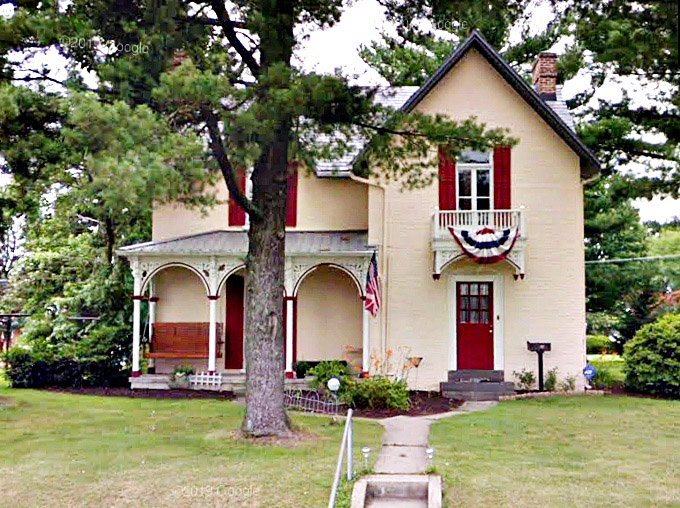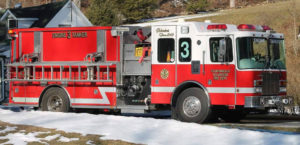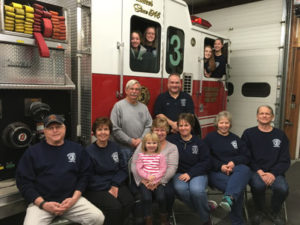The Johns Farmhouse Story
Richard D. L. Fulton

Among the mass of paranormal photographs taken over the decades, one occasionally encounters a photograph that includes a house or structure that no longer exists, or a plantation-like stairway with Victorian inhabitants apparently standing upon it that never existed.
But how about a farmhouse that appears in a Civil War picture 16 years before the farmhouse was built? As strange as that may sound, there is actually a rational explanation for the strange “apparitions.”
On July 1 through July 3. 1863, a ‘terrible storm’ swept through Gettysburg as the Confederate Army of Northern Virginia and the Union Army of the Potomac collided on the fields and hills in and surrounding the quiet country borough of Adams County.
The battle that raged for three days ultimately climaxed with the so-called “Pickett’s Charge,” which failed in the final attempt of Confederate General Robert E, Lee to break through the Union lines on Cemetery Ridge under the command of Union General George A. Meade.
The cataclysmic charge and the defense of the Union line was commemorated in a painting known as the Battle of Gettysburg Cyclorama, which has been on display at the various incarnations of the Gettysburg Battlefield Park’s Cyclorama for decades (including initially at a building at the entrance to the national cemetery).
In the 1880s, French artist Paul Philippoteaux painted four versions of his “Pickett’s Charge” cycloramas, including one which went on display in Boston in 1884. In 1913, the Boston version was purchased and displayed in Gettysburg for the 50th Anniversary of the battle and was displayed in a building near the entrance of the Soldiers’ National Cemetery.
Philippoteau’s painting was ultimately purchased by the National Park Service in 1942 and was moved to its first NPS home, a building within the park. In 1963, the painting was moved into a new visitor center, and again in 2005, the painting was moved to the current visitor center.
While the painting had to be restored (it had actually been cut into pieces before it was purchased in 1913), no one caught onto, or covered-over the farmhouse that didn’t exist.
The farmhouse in question appears at the left flank of Pickett’s Charge, essentially in the background. As it turns out, the farmhouse was constructed in 1879 by Samuel Bushman (now commonly referred to as being the William Johns farmhouse).
So how did it end up in a Civil War painting? According to Mike Tallent and Ron Frenette, who purchased the old farmhouse in 2014, Philippoteau never left France to view the battlefield, but instead, he had hired photographers to take photographs of the areas to be painted. The photographs were taken in the very early 1880s (before the paintings were executed), after the farmhouse had been built.
Thus, unaware of the unintended anachronism, Philippoteau included the 1879 Bushman home in his “Pickett’s Charge” painting.
Well, at least the land the farmhouse sits upon—which stands on the corner of Johns Avenue and Culp Street—did see plenty of fire and fury on July 4, 1863, as can be testified to by the voluminous number of bullets, shells fragments—even unexploded artillery rounds—that have been collected on the farmhouse property, and those of the neighboring properties that now comprise the Colt Park development.
The property and those surrounding the farmhouse turned up more than just relics. The front of the Johns farmhouse all the way from Culp’s Street to King Street was a temporary Confederate mass grave (the bodies were subsequently removed). In 1882, a trench was dug 300 yards from the farmhouse wherein 15 Confederate bodies were found. Again, in 1914, two more bodies were recovered near the barn, next to the farmhouse.
Civil War history aside, in 1913, Gettysburg served as the host to the Civil War Veterans’ Reunion, and the sprawling encampment all but encircled the farmhouse property. In 1918, Camp Colt (where the War Department trained the U.S. Army’s first tank unit) was established and basically encompassed the same ground as did the 1913 veterans’ reunion. More than 150 troops encamped in Camp Colt died from the Spanish Flu in 1918.
The Johns farmhouse and the land it was built upon didn’t get much of a break when it came to being witness to tragic events.
In 1922, during the Marine maneuvers at Gettysburg, death came precariously close to landing in the front yard of the old farmhouse when a warplane fell from the sky, killing the pilot and his passenger.
Highly-decorated World War I Marine infantryman Captain George Wallis Hamilton—turned Marine aviator in the aftermath of the war—was piloting a de Havilland DH-4B dive-bomber on June 26, along with passenger, Gunnery Sergeant George Russell Martin, at the head of the Marine column as the column approached the Gettysburg Battlefield.
The more than 5,000 Marines had marched from Quantico to hold their Civil War-theme summer maneuvers and battle reenactment in Gettysburg, and squadrons of bi-wing airplanes flew overhead, as if patrolling the skies during the Marines’ advance.
Hamilton was in command of the lead squadron as it approached the battlefield. The squadron was in the process of preparing to land at an impromptu airfield the Marines had constructed on the Culp Farm near the intersection of Old Emmitsburg Road and Long Lane.
As Hamilton’s squadron circled to position themselves to land, the other pilots, as well as other witnesses on the ground, stated that the captain’s “DH-4B airplane #6157 went into a tailspin from a left turn from which it did not recover, and crashed to the ground,” according to the crash investigatory Record of Proceedings.
The crash occurred in the area of Johns Avenue and Culp Street, just missing a carnival that had been set up along Steinwehr Avenue, precariously close to the front yard of the Johns farmhouse.
Hamilton was found deceased in the wreckage, but Martin was still alive. He was transported to the Warren Hospital (Gettysburg Hospital), where he expired a short time later. Because both were engaged in Marine activities at the time of the crash, they then both became the last line-of-duty deaths to have taken place on the old Civil War battlefield since 1863.
Today, the site of the crash is marked by a memorial wayside dedicated to the two aviators who had perished on June 26, 1922. The memorial was created by a consortium of area residents, members of the Gettysburg and Emmitsburg Marine Corps Leagues, and the Gettysburg Heritage Center.
A photograph of the Johns farmhouse was included in the wayside, as it was the only nearby structure that had existed in that area at the time of the crash. Johns farmhouse owners Mike Tallent and Ron Frenette played instrumental roles in not only raising the funds to erect the memorial and designing it, but also in helping to create the subsequent dedication ceremony when the memorial wayside was unveiled.
The memorial wayside dedication was held on June 26, 2018. Members of the US Marine Corps Historical Company, Marines from Fort Meade, and a Marine bugler from Marine Base Quantico participated in the dedication ceremony.
Frenette stated at the ceremony that the book, The Last to Fall: The 1922 March, Battles, & Deaths of U.S. Marines at Gettysburg by Richard D. L. Fulton and James Rada, Jr., had inspired the effort to create the memorial to the two aviators.

 State and county lines are no barrier when it comes to fighting fires. The Fountaindale Volunteer Fire Department is located in Adams County, Pennsylvania, but when needed, they provide mutual aid to Frederick and Washington counties in Maryland, as well as Franklin County in Pennsylvania.
State and county lines are no barrier when it comes to fighting fires. The Fountaindale Volunteer Fire Department is located in Adams County, Pennsylvania, but when needed, they provide mutual aid to Frederick and Washington counties in Maryland, as well as Franklin County in Pennsylvania.
